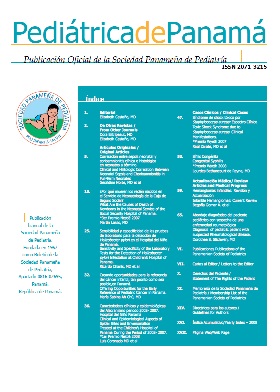Impact in the early diagnosis of hemolytic disease of the newborn in neonates greater than 2kg by screening bilirubins by transcutaneous method
[Impact in the early diagnosis of hemolytic disease of the newborn in neonates greater than 2kg by screening bilirubins by transcutaneous method ]2020-01-01
Downloads
Keywords:
Isoinmunización, ABO, Rh, enfermedad hemolítica, recién nacidoKeywords:
Isoimmunization , ABO, Rh, haemolytic disease, newbornAbstract
Introducción: La enfermedad hemolítica del recién nacido es una afección inmunológica autoinmunitaria en la cual la vida del hematíe es acortada como resultado por la acción de anticuerpos maternos. La gravedad de la enfermedad se asocia a anemia, trombocitopenia, muerte fetal intraútero, kernicterus, defectos en la coagulación, hipoglicemia, ascitis e hydrps. El objetivo de este estudio fue comparar el impacto de la implementación de intervenciones para el diagnóstico de esta patología en el servicio de neonatología del Hospital del Niño.Materiales y métodos: Se evaluó recién nacidos de la maternidad del Hospital Santo Tomás> 2 kg con diagnóstico de isoinmunización (ABO o Rh) en dos períodos, antes y después de la implementación del tamizaje de las bilirrubinas por método transcutáneo desde 1 enero 2015 a 31 diciembre 2016; se tomó en cuenta el tipo de isoinmunización, la edad al momento del diagnóstico, días de fototerapia que recibe, días intrahospitalarios, uso de inmunoglobulinas y complicaciones, se obtiene valor de P para comparar un período con otro y evaluar su significancia .Resultados: Se obtienen 460 pacientes; 230 para cada período. Cumplen con los criterios de inclusión un total de 422 pacientes (203 para el primer periodo y 219 para el segundo). Entre los resultados se observó que un 95.6% la incompatibilidad de grupo ABO predominó sobre la isoinmunización Rh en ambos períodos; con leve prevalencia de la isoinmunización OA. La bilirrubinas séricas al momento del ingreso a sala de neonatología 2 disminuyó> 5 mg/dl en el segundo periodo (13.27 y 8.05 respectivamente) y en cuanto a los días de fototerapia se encontró disminución de 4.2 días para el primer período y 2.6 días en el segundo período, lo mismo que la estancia intrahospitalaria de 5.2 a 2.8 días. <br />La edad al momento del diagnóstico disminuyó de 33.8horas a 15.4 horas en el segundo periodo y la frecuencia de exanguino-transfusiones disminuyó de 6.9% a 2.3% en el segundo periodo.Conclusión: Se observó la captación temprana de pacientes con enfermedad hemolítica del recién nacido, disminuyendo la duración de estancia intrahospitalaria.
Abstract
Introduction: The hemolytic disease of the newborn is an autoimmune immunological condition in which the life of the erythrocyte is shortened as a result of the action of maternal antibodies. The severity of the disease is associated with anemia, thrombocytopenia, intrauterine fetal death, kernicterus, coagulation defects, hypoglycemia, ascites and hydrps. The objective of this study was to compare the impact of the implementation of interventions for the diagnosis of this pathology in the neonatology service of the Hospital del Niño. Materials and methods: Newborn infants from Santo Tomás Hospital> 2 kg were evaluated with diagnosis of isoimmunization (ABO or Rh) in two periods, before and after the implementation of bilirubin screening by transcutaneous method from January 1, 2015 to December 31, 2016; the type of isoimmunization, age at diagnosis, days of phototherapy received, hospital days, use of immunoglobulins and complications were taken into account, P value is obtained to compare one period with another and evaluate its significance. Results: 460 patients are obtained; 230 for each period. A total of 422 patients met the inclusion criteria (203 for the first period and 219 for the second). Among the results, it was observed that 95.6% of ABO group incompatibility predominated over Rh isoimmunization in both periods; with mild prevalence of OA isoimmunization. Serum bilirubins at the time of admission to neonatal ward 2 decreased> 5 mg / dl in the second period (13.27 and 8.05 respectively) and in terms of the days of phototherapy a decrease of 4.2 days was found for the first period and 2.6 days in the second period, as well as the inpatient stay from 5.2 to 2.8 days. The age at the time of diagnosis decreased from 33.8 hours to 15.4 hours in the second period and the frequency of exanguine-transfusions decreased from 6.9% to 2.3% in the second period. Conclusion: Early uptake of born with hemolytic disease was observed, decreasing the duration of in-hospital stay.
License
Copyright (c) 2020 Infomedic InternationalDerechos autoriales y de reproducibilidad. La Revista Pediátrica de Panamá es un ente académico, sin fines de lucro, que forma parte de la Sociedad Panameña de Pediatría. Sus publicaciones son de tipo ACCESO GRATUITO y PERMANENTE de su contenido para uso individual y académico, sin restricción. Los derechos autoriales de cada artículo son retenidos por sus autores. Al Publicar en la Revista, el autor otorga Licencia permanente, exclusiva, e irrevocable a la Sociedad para la edición del manuscrito, y otorga a la empresa editorial, Infomedic International Licencia de uso de distribución, indexación y comercial exclusiva, permanente e irrevocable de su contenido y para la generación de productos y servicios derivados del mismo.






